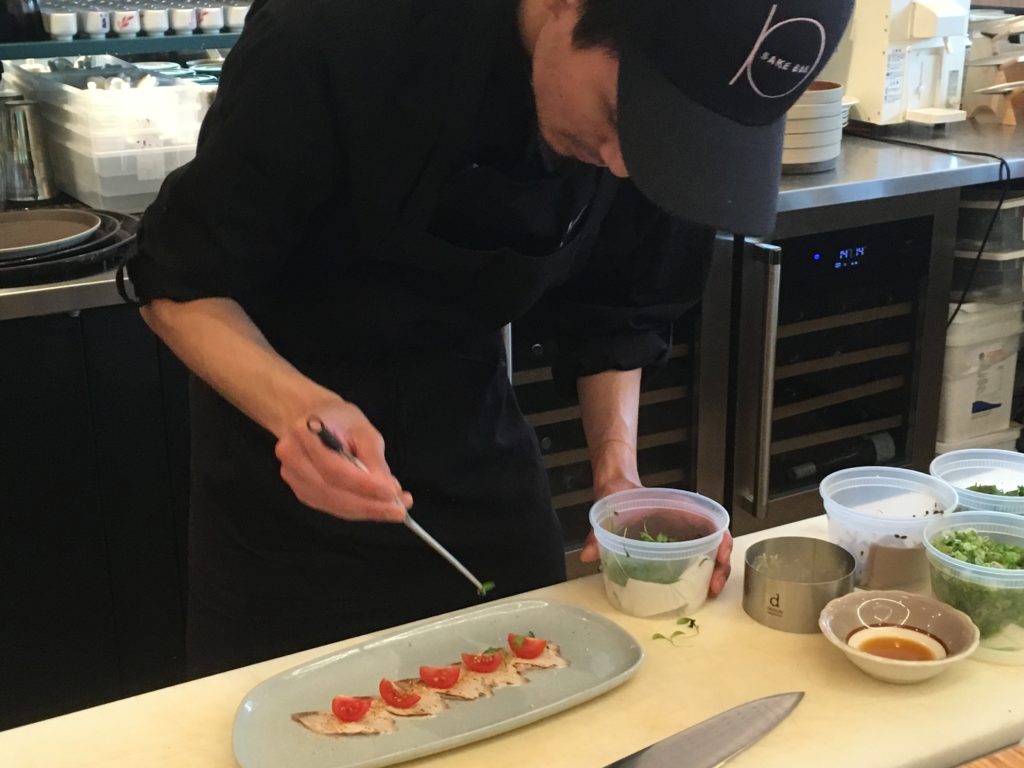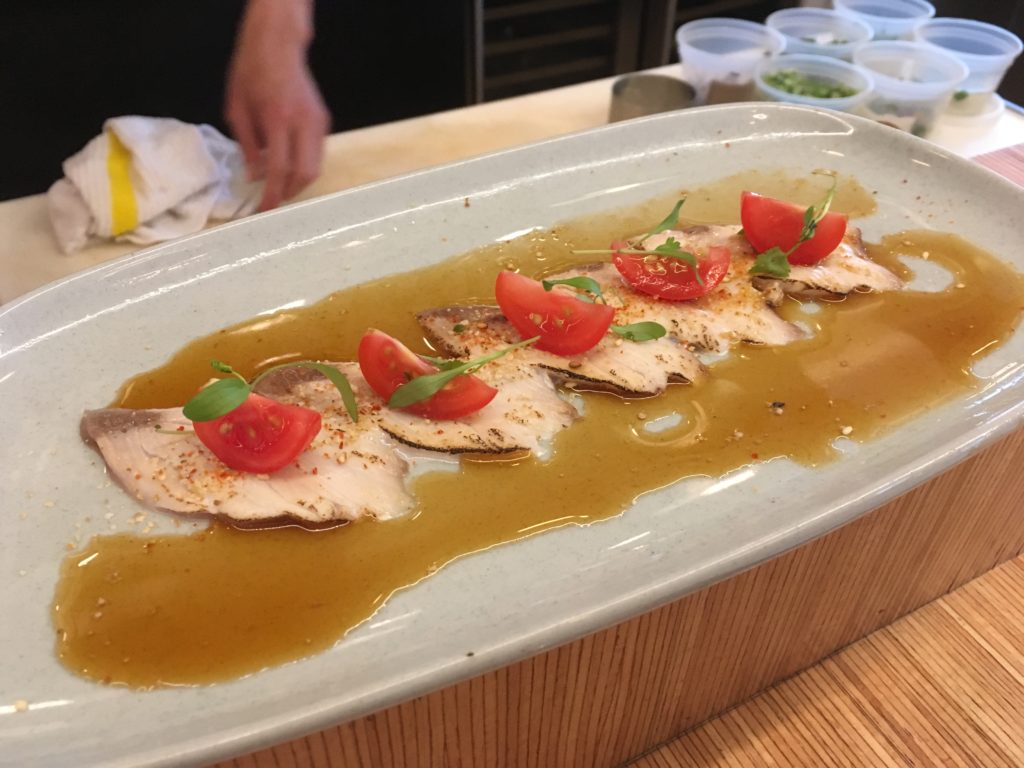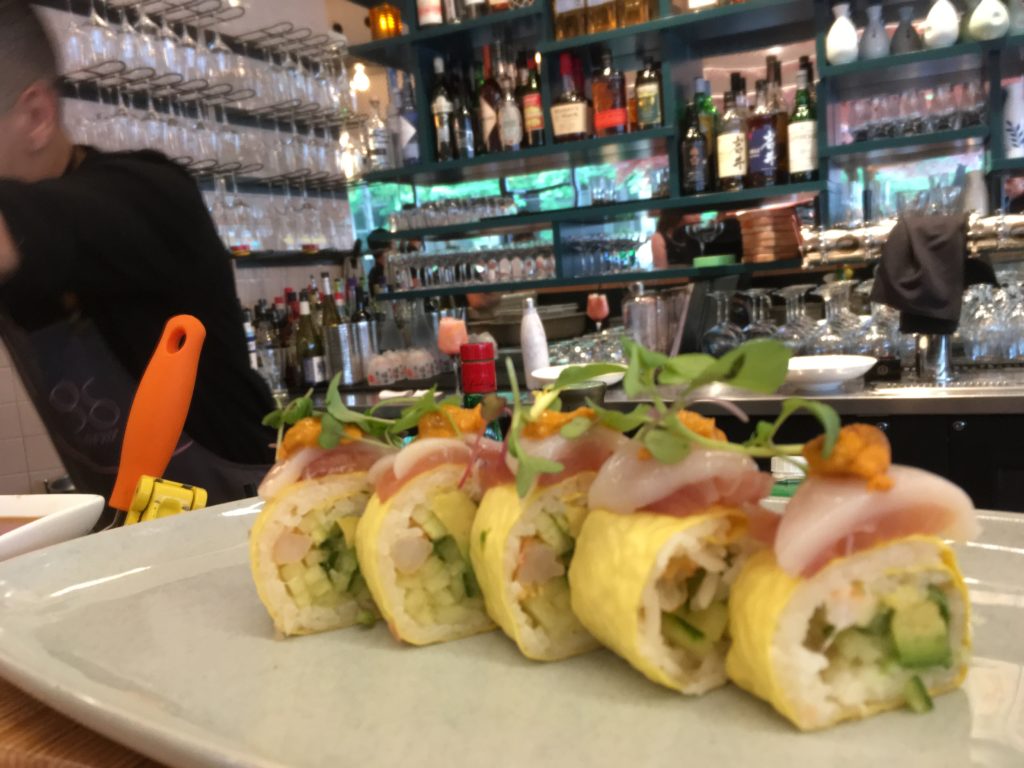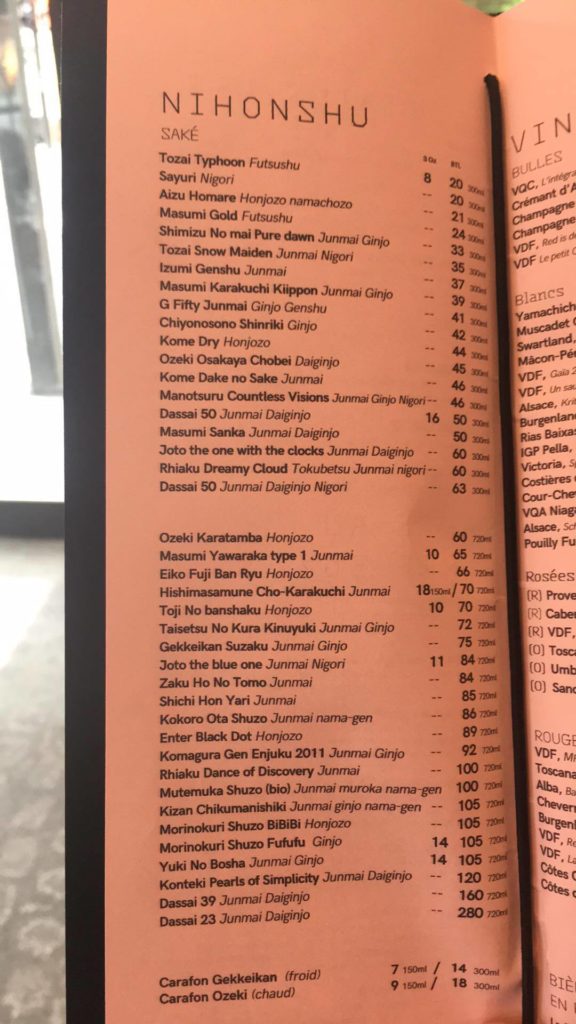Last year, I worked with talented, food and lifestyle photographer Sylvie Li on a photo shoot of sushi for my blog. I bought a whole, giant, (sustainable) $200 salmon, filleted it, skinned most of it, cut it into pieces a little larger than a deck of cards and sliced some of these into sashimi. Some of these thin slices I layered over hand-shaped rice for nigiri and some I singed with a kitchen torch.
I’d splurged on the torch – a hand-held fire machine for food – to try my hand at Aburi sushi, a fairly recent sushi trend that started in Japan before coming to North America. The fat melts into the fish and you end up with a textured top and creamy, raw belly on top of warm, seasoned rice. The theory is that rendering the fat makes it healthier, but as you don’t see pools of fat under the nigiri, all the fat sticks nicely – and deliciously – in the rice.
There was enough delicious, sashimi-quality flesh and fat on the $200 Ora King salmon that I bought to make hundreds of sashimi slices. That alone justified the purchase, since it was a one-time investment for a high return on quality protein. So I have a good idea how much it cost to make five slices of hamachi, a fish that would probably be around the same price per pound as the salmon I bought. The plate of five slices below goes for $15 at Le Blossom, or $3 a blowtorched slice.


I felt as though I were eating money with each tiny bite. $3. Chew, swallow. $3. Try to chew slower. Swallow. It was gone all too fast.
The price of a plate of five slices with cherry tomato wedges, bitter greens and a light (gluten free upon request) soy and yuzu sauce is justified only because the bottles of sake on the menu are so reasonable. I’ll get to those in a minute, but first the rest of the menu:
I’d seen on the restaurant/bar’s online menu that they had tuna rolls for $5 – a steal! I thought. But when I went in the evening, the menu was much shorter and much more expensive. The cheapest thing was a tiny bowl of sesame oil, salt and togarashi-ed edamame. The only maki I was interested in was $18, which I scoffed at until it was set in front of me with five dabs of uni on top of creamy raw scallop, itself on top of tender yellowtail (amberjack, not tuna), over a soy paper inside-out roll of avocado, shiso, shrimp and cucumber. I didn’t miss the tempura shrimp or ikura that I couldn’t have (not gluten free) and I couldn’t taste the jalapeño or yuzu, but maybe they had to leave them out to make it gluten free, or maybe the yuzu was in the gluten free dipping sauce on the side.
Either way, price justified:

But I could only afford to order one, because it would have taken three of these to be full, and without any cheaper filler maki roll options (e.g. cucumber, avocado, tuna), I chose to spend more money on sake.
We got two 300mL bottles instead of one larger 720mL, because half of 720 is just too much for me. Thankfully, you could take home a half drank bottle, but it goes down so easy that ordering the 720mL would run the risk of drinking too much without meaning to.
The other reason I came here, besides the supposedly cheap tuna rolls, was the nama sake selection. Bacchus 76 has started importing some of these beauties in Montreal at reasonable prices. There are a couple other import companies importing sakés, but they say the demand isn’t high enough for namas to justify bringing them in. But how are people supposed to learn if they have no access? I have this same argument about quality imported fish (and local, for that matter), but for now I’ll focus on rice wine.
Nama means unpasteurized, so you can think of these sakés like natural wines or unpasteurized cheeses: so much more life and flavour. They’re also more volatile, meaning harder to transport and store, but the payoff in terms of amino acids and enzymes (aka taste and healthiness) can be big. There are four on the menu at the moment.

They are $86, $100 and $105 per bottle, and the fourth is $20. The Aizu Homare ($20, 300mL) is a honjozo, which means grain alcohol has been added. That kind of negates the whole unpasteurized thing (on the flip side, it makes it more stable), but you still get some of the nama flavour (heightened acidity and freshness, or at least that’s what I tasted). It was actually only 13.5% alcohol total, though, which isn’t too high, and was actually lower than the non-honjozo bottle we had afterwards. The taste of the Aizu Homare was a little sweet and a little boozy, but it didn’t bite or burn, and it had a refreshing quality that cut through the alcohol. Served a little cooler, around 10˚C, I think our server said, it’s a little more refreshing. We had a glass and put the bottle on ice for our next round. Since saké is served in small glasses, you don’t end up sipping through too-hot liquid for long, unlike wine, where you have to get through an entire 8 oz. glass if the bottle isn’t properly chilled yet.
The second bottle we got was the Kome Dake no Sake ($46, 300mL). It’s a Junmai (no added alcohol, but no minimum rice grain polishing percentage). I’m usually a Junmai dai Gingo snob. That’s sake made with a higher rice polish percentage than Junmai or Junmai Ginjo (Junmai means no grain added alcohol, unlike the honjozo above). Junmai dai Gingo’s are often purer, drier, more delicate. But that doesn’t mean they’re always better. Sometimes you want bigger flavours, more volatile compounds, more flowers in the smell, more sweetness. This Kome Dake no Sake was drier, funkier – like truffles and earth. It’s a food saké, I feel. On its own, it’s a bit off-putting to me, but I don’t like truffles… Still, we had no problem finishing this bottle either, ordering the unsustainable Atlantic salmon tartare with MSG-heavy Japanese Kewpie mayo and freshly fried taro chips. I think the dish was around $15. I personally think Atlantic salmon should always be cooked, because the quality is fairly low thanks to the potential for disease and excess antibiotics in the crowded water, but when there’s nothing else reasonably priced on the menu, and you’ve been sucking back alcohol for a few hours, you bend.
Why doesn’t the kitchen do cheaper maki rolls anymore? I asked. Rolling tons of maki on a Saturday night is very time consuming for a kitchen, I was told. I understand, but it’s still sad that the option is no longer there. I’m sure it would take less time than the torched hamachi, but the price makes that effort worthwhile. $5 maki? Not so much. Too bad for me. I’ll just have to order a case of nama from Bacchus and make my own sustainable sushi at home.
But then I wouldn’t get to sit on the restaurant’s pretty terrasse, or under the giant, artificial cherry blossom tree above a curving group table where a bachelorette party held court for a few hours that evening. (The bride-to-be spent a split-second behind the bar, faking making a cocktail, and then the matching t-shirt-wearing party were off to their next stop.) The decor is sleek wood with a wraparound bar, a huge step up from the last cheap, constantly deserted restaurant that was here.
The bar told me they’d start offering a nama sake by the glass soon (because it’s unpasteurized, it doesn’t last as long once opened, so it’s hard not to waste it if they sell it by the glass, they explained). I’ll also be back next week with some friends – preferably on Sunday, when saké is 50% off – to try a more expensive bottle of unpasteurized sake, while waiting to hear back from Bacchus about a case…
Le Blossom
Hours: Sun, Tues-Wed 5pm-midnight, Thurs-Fri 11:30am-2:30pm, 5pm-1am, Sat 5pm-1am
Phone: 514-379-3699
Address: 1101 Boulevard de Maisonneuve Est
Reservations
Leave a Reply